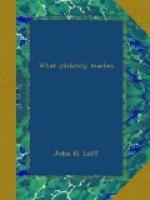[Illustration: Stamp Arrangement, “Newfoundland”, 3 pence]
The triangular stamps of the Cape of Good Hope and New Foundland are so arranged in the plate that half of them are tete beche to the other half. The same is true of the stamps of Grenada of the issue of 1883.
[Illustration: Stamp, “Hawaiian Postage”, 5 cents]
[Illustration: Stamp, “Petersburg, Virgina”, 5 cents]
[Illustration: Stamp, “Eranco en Guadalajara”, 2 reales]
[Illustration: Stamp, “Ile de la Reunion”, 15 centimes]
Another form of typography is found in stamps which are composed of printer’s type and ornaments. These are usually called “type-set”, to distinguish them from stamps produced by the normal process of typography. Stamps made in this manner are often of a high degree of rarity, having been produced in remote parts of the world, where facilities were limited and the use of stamps restricted. To this class belong the stamps of the first issues of British Guiana, Hawaii and Reunion, which rank among the greatest philatelic rarities. We show you here a number of type-set stamps. The first was used in the Hawaiian Islands, in payment of postage on letters between the different islands. There are a number of plates of these stamps, of different values, and each containing ten varieties. The second stamp was issued by the postmaster of Petersburg, Va., in the early days of the war of the rebellion and before the postal service of the Confederate government was in working order. The third was used in the city of Guadalajara, Mexico, in 1869, during the war between France and that country. It was made from the cancellation stamp in use in the post office, the usual date being replaced by the value. The stamps were struck by hand on sheets of paper which had been previously ruled into squares with a lead pencil. The fourth stamp is one of the Reunion stamps previously mentioned. There were eight stamps in the setting, four having a central device like the stamp shown, and the other four being of a different design.
It is interesting to remark that most of these type-set stamps show an evidence of their provisional nature and the stress under which they were made, in the paper on which they were printed. It was usually writing paper, such as would be found at a stationers at that period. Some of the rare type-set stamps of British Guiana were printed on the paper used for lining sugar barrels.
[Illustration: Stamp, “Shanghai LPO”, 2 candareens]
The stamps of the first issue of Shanghai supply an unique variety in typographed stamps. In these stamps the central design is cut upon a block of ivory and the surroundings are set up from printer’s type and rules. The stamps were printed one at a time upon a hand press. The value, in both English and Chinese, was changed as required, and it is recorded that on occasions the different values were produced literally “while you wait.” Under such circumstances it is not surprising to learn that minor varieties are very numerous.




